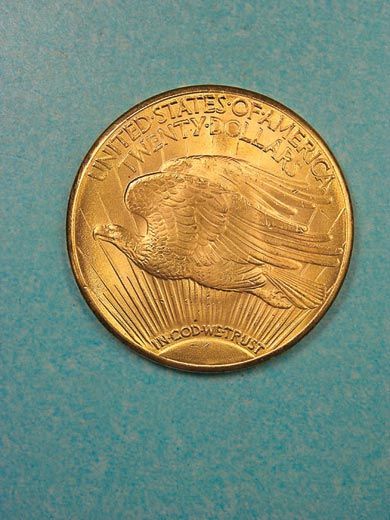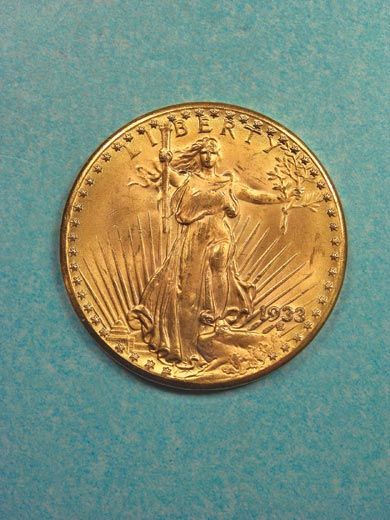Golden Grail
Few U.S. coins are rarer than the never circulated 1933 double eagle, melted down after the nation dropped the gold standard
These days, with the mighty greenback looking green at the gills and the euro laughing all the way to the bank, even our once-durable coinage is under assault. Critics are calling for the extinction of the penny; although Thomas Jefferson still graces the nickel, his portrait has been reworked; and quarters come in 50 flavors. And whatever happened to the half dollar? What's worse, nobody seems to care about the aesthetics of pocket change.
There was a time when coins were small masterpieces crafted by artists, when no less a personage than President Theodore Roosevelt took an interest in their design. Two almost impossibly rare gold pieces in the collection of the Smithsonian National Museum of American History (NMAH) testify to TR's quest for numismatic glory.
In the early 1900s, the president decided that the $20 double eagle (fashioned after the $10 coin bearing the image of our national bird), in circulation since the mid-19th century, needed a face-lift. To do the job, he called on America's preeminent sculptor, Augustus Saint-Gaudens, who had designed TR's 1905 inaugural medal.
Although Saint-Gaudens was terminally ill—he would die of cancer in August 1907—the sculptor created what many consider to be the most beautiful coin this country ever minted. One side depicts an eagle in flight; on the obverse, the figure of Liberty strides forward, torch in one hand and olive branch in the other, her hair streaming behind her. The model was Harriette Eugenia Anderson, a young woman originally from South Carolina; Saint-Gaudens described her as "certainly the handsomest model I have ever seen of either sex."
The new double eagle, introduced in 1907, was coin of the realm for the next 16 years, until Teddy's cousin, President Franklin Roosevelt, moved the country off the gold standard in 1933. Gold coins of all denominations were ordered exchanged for paper currency. (Collectors were exempted from the law, a loophole that has resulted in any number of lawsuits.)
At the nation's Mints in 1933, gold coins were melted down and converted into ingots. According to Alison Frankel, author of Double Eagle: The Epic Story of the World's Most Valuable Coin, George McCann, a laborer at the Philadephia Mint, seems to have succumbed to a temptation—just as the last of the uncirculated 1933 double eagles were headed to the melting chamber. "There are many instances," says Frankel, "of people pocketing coins that are about to become rare."
Only nine days later, after 2,000-degree fires had turned most of Saint-Gaudens' masterpieces into mush, a Philadelphia jeweler, Izzy Switt, would sell one double eagle, almost certainly obtained from McCann, to a coin collector.
Because 1933 double eagles were never circulated and were thought to have all been melted down, collectors view the handful in existence as the most numinous of numismatic treasure. Mystery continues to surround them. "We don't know how many survived," says Richard Doty, an NMAH curator.
According to Doty, the Smithsonian received its pair of 1933 double eagles in 1934. The federal government donated the gold pieces, Doty says, as "coins of record." (NMAH holdings contain examples of virtually every form of coinage produced by the U.S. Mint.)
Another 1933 double eagle to escape destruction owes its existence to Egypt's King Farouk. A passionate coin collector, Farouk somehow arranged for a double eagle to be shipped to Cairo only days before Secret Service agents began rounding up all unsurrendered gold coins. After Farouk was overthrown in 1952, his extensive collections were auctioned. One lot contained his double eagle; the United States demanded that it be returned. Though the Egyptians removed the coin from auction, it disappeared for many years.
In the mid-1990s, a 1933 double eagle—in all likelihood Farouk's—turned up in the hands of British coin dealer Roger Fenton. After a convoluted legal battle, it was auctioned at Sotheby's for $7.59 million in 2002. (Fenton and the U.S. government split the proceeds.)
At the time, this coin and the Smithsonian's pair were thought to be the only 1933 double eagles. But then, in August 2005, says Doty, "ten more surfaced." The owner: none other than Philadelphia jeweler Izzy Switt's daughter. The federal government wants those coins back. Lawsuits are pending. "I've seen all ten at an exhibition in Denver," Doty says. "For collectors, it was a religious experience."
Owen Edwards is a freelance writer and author of the book Elegant Solutions.
/https://tf-cmsv2-smithsonianmag-media.s3.amazonaws.com/accounts/headshot/Owen-Edwards-240.jpg)


/https://tf-cmsv2-smithsonianmag-media.s3.amazonaws.com/accounts/headshot/Owen-Edwards-240.jpg)